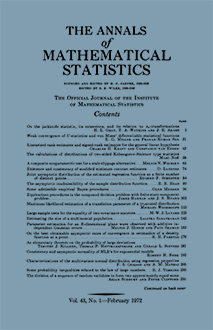Abstract
The application of integral equations to renewal theory in population analysis and problems of industrial replacement is beset with certain difficulties which have been particularly discussed by W. Feller (these Annals 1941 vol. 12 pp. 243-267). Some of these difficulties are avoided if the data of the problem are introduced into the analysis directly in the discontinuous form (tabulated by class intervals) in which they are usually supplied in a concrete case. A numerical example based on population statistics is presented, illustrating how, using discontinuous data, a recurrent series takes the place of the integral equation, and a finite exponential series appears in place of the Heaviside expansion of the previous solution. There is close analogy with the procedure previously presented, but with factorial moments appearing in place of ordinary moments. The fundamental data being given for values of the replacement function at discrete intervals only, some question arises as to the applicability of the solution as an "interpolation" formula for non-integral values of the time $t$, and as to the effects of subdividing the class interval of the original data. In the actual computation of the factorial moments a shift of origin by one-half class interval becomes necessary. An algorithm for effecting this shift is presented.
Citation
Alfred J. Lotka. "Application of Recurrent Series in Renewal Theory." Ann. Math. Statist. 19 (2) 190 - 206, June, 1948. https://doi.org/10.1214/aoms/1177730244
Information





